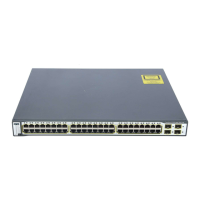Contents
xxiv
Catalyst 3750 Switch Software Configuration Guide
78-16180-02
CHAPTER
32 Configuring QoS 32-1
Understanding QoS 32-1
Basic QoS Model 32-3
Classification 32-4
Classification Based on QoS ACLs 32-7
Classification Based on Class Maps and Policy Maps 32-7
Policing and Marking 32-8
Mapping Tables 32-10
Queueing and Scheduling Overview 32-11
Weighted Tail Drop 32-11
SRR Shaping and Sharing 32-12
Queueing and Scheduling on Ingress Queues 32-13
Queueing and Scheduling on Egress Queues 32-15
Packet Modification 32-17
Configuring Auto-QoS 32-18
Generated Auto-QoS Configuration 32-18
Effects of Auto-QoS on the Configuration 32-23
Auto-QoS Configuration Guidelines 32-23
Upgrading from a Previous Software Release 32-24
Enabling Auto-QoS for VoIP 32-24
Auto-QoS Configuration Example 32-26
Displaying Auto-QoS Information 32-28
Configuring Standard QoS 32-28
Default Standard QoS Configuration 32-29
Default Ingress Queue Configuration 32-29
Default Egress Queue Configuration 32-30
Default Mapping Table Configuration 32-30
Standard QoS Configuration Guidelines 32-31
Enabling QoS Globally 32-32
Configuring Classification Using Port Trust States 32-32
Configuring the Trust State on Ports within the QoS Domain 32-32
Configuring the CoS Value for an Interface 32-34
Configuring a Trusted Boundary to Ensure Port Security 32-35
Configuring the DSCP Trust State on a Port Bordering Another QoS Domain 32-36
Configuring a QoS Policy 32-38
Classifying Traffic by Using ACLs 32-38
Classifying Traffic by Using Class Maps 32-42
Classifying, Policing, and Marking Traffic by Using Policy Maps 32-44
Classifying, Policing, and Marking Traffic by Using Aggregate Policers 32-47

